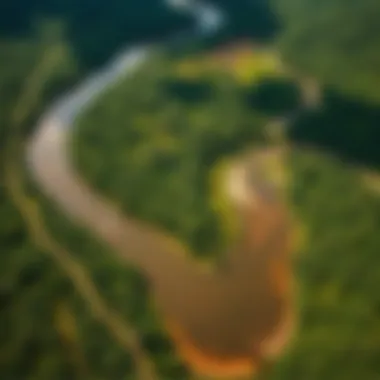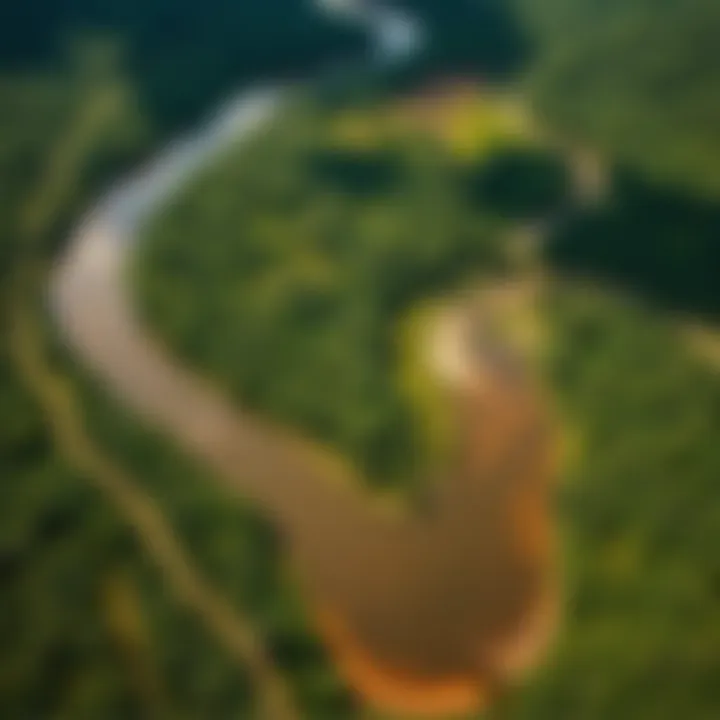Exploring the Amazon Rainforest: Ecology and Significance


Intro
The Amazon Rainforest is not just a collection of trees and wildlife; it's a vibrant tapestry of life that plays an irreplaceable role in our planet's health. Spanning over five and a half million square kilometers, it covers parts of several countries, including Brazil, Peru, and Colombia. Often referred to as the "lungs of the Earth," it generates about 20% of the world’s oxygen and is a key player in regulating the global climate. Understanding the Amazon is vital for grasping the larger picture of ecological balance, sustainability, and cultural richness.
But what makes this rainforest truly captivating goes beyond its sheer size and oxygen output. The relationship between the countless species inhabiting its depths adds layers of complexity to its ecosystems. Each organism, from the tiniest fungi to the largest mammals, weaves into the environmental fabric, making the Amazon an exemplary model of biodiversity.
Within its bounds, there exists a delicate balance. Elements like soil quality, water purity, and climate play integral roles in maintaining this vast ecosystem. But the impact of human activities—deforestation, mining, and agriculture—poses severe threats to this balance. Moreover, understanding these threats also requires looking at how local communities depend on the rainforest for their livelihoods and cultural practices.
A comprehensive exploration of the Amazon requires delving into its ecological relationships, interpreting current trends, and analyzing conservation efforts. As we move through the sections, we will discover how these components influence the broader environmental narrative.
With this foundation, let's transition into the Key Concepts and Terminology that will serve as the skeleton for our deeper exploration of the Amazon Rainforest's ecological significance.
Prologue to the Amazon Rainforest
The Amazon Rainforest, stretching across several nations in South America, plays a vital role in the earth's ecosystem. It’s not merely a collection of plants and animals; it’s a living, breathing entity that supports a complex web of life. Many may underestimate this verdant expanse, but its impact on global health and climate cannot be overstated. The rainforest’s biodiversity holds key lessons for sustainable practices, making it essential for agriculture enthusiasts and farmers.
In this segment, there are profound benefits to understanding the nuances of the Amazon. First, the rainforest is a treasure trove of genetic diversity, housing many species that might one day provide new crops or medicinal compounds. Furthermore, the intricate relationships within the forest reveal how interconnected ecosystems operate, offering insights that could reshape agricultural methods.
One cannot emphasize enough the importance of the ecological balance maintained by the Amazon. Enveloping 5.5 million square kilometers, it is often dubbed the "lungs of the planet," generating approximately 20% of the world’s oxygen. This aspect alone underscores the need for urgency in conservation efforts.
Let's delve deeper into the geographical roots and historical context of this magnificent forest, laying the groundwork for appreciating its significance today.
Geographical Overview
Encompassing parts of Brazil, Peru, Colombia, Venezuela, Ecuador, Bolivia, Guyana, Suriname, and French Guiana, the Amazon Rainforest exudes an immense geographical footprint. Nestled within the Amazon Basin, the terrain presents an intricate tapestry of river systems, wetlands, and mountains – crucial for its unique ecological dynamics.
The Amazon River, one of the longest rivers in the world, meanders through the forest, feeding into various tributaries. Its sheer volume influences local weather patterns, showcasing the dependency of numerous habitats on these waterways. Rainfall can reach up to 3,000 millimeters annually in certain areas, promoting a lush environment that is conducive to the diverse plant and animal life that thrives therein.
Nutrient-poor soils are a striking feature of the Amazon landscape. Despite this, the rainforest sustains a myriad of species through thick canopies that shield the forest floor from the full brunt of sunlight, creating microclimates. Each layer – from emergent trees to the forest understory – plays a role in the ecosystem's health and the stability of agricultural activities tied to these natural processes.
Historical Significance
The Amazon is not just a natural wonder; it carries a significant historical narrative. For centuries, it has been home to numerous Indigenous peoples, who have cultivated a deep connection with the land. These communities relied on the forest's resources for food, shelter, and medicine, crafting sustainable practices that have persisted over generations.
The arrival of European conquerors in the 16th century marked a turning point in the region’s history. Their quest for riches led to exploitative practices that began to unravel the social and ecological fabric of the Amazon. As rubber, timber, and gold became highly sought-after commodities, vast areas of the forest fell victim to over-extraction. This not only marginalized local populations but also disrupted the delicate balance of the ecosystem.
In recent decades, the historical significance of the Amazon has evolved to encompass global awareness and action regarding environmental issues. The uptake of deforestation and its implications on climate change has turned the rainforest into a focal point for environmentalists worldwide. Understanding this history equips agricultural professionals with the insights needed to advocate for practices that honor both the land and its people, fostering a sustainable future.
"The Amazon is more than a forest; it shows how interconnected we all are, from local farmers to global citizens."
Biodiversity of the Amazon
The Amazon Rainforest is famed for its staggering biodiversity that acts as a cornerstone of this ecosystem. From towering trees to elusive animals creeping under the forest bed, each organism plays its part. The interwoven fabric of life found here functions not only as a vibrant ecological tapestry but also serves essential roles in medicine, agriculture, and climate regulation. This section delves into the rich variety of species found in the Amazon, shedding light on their unique contributions and the precarious state of their existence.
Flora: A Study of Plant Life
Common Species
The Amazon is home to countless plant species, many of which are endemic to the region. Leading the charge are the towering Brazil nut trees and the medicinally rich eucalyptus. These common species play an integral role in sustaining diverse wildlife and contributing to the region's carbon storage capabilities. Brazil nut trees, for instance, can grow to heights of over 50 meters and have shallow root systems, allowing them to gather moisture rapidly. This characteristic means that they often serve as critical habitat structures for a multitude of animals, enhancing overall ecological health. Moreover, their fruit is a vital food source for certain animal species, thus intertwining their existence with the fauna of the forest.
Medicinal Plants
Medicinal plants within the Amazon are not just a treasure for traditional practices but are increasingly important for modern medicine. For instance, the Himatanthus sucuuba tree holds compounds that are being researched for their potential use in treating various illnesses. Ethnobotanical studies show that indigenous peoples have used its latex for centuries to treat infections. However, the knowledge of these plants and their uses is at risk of vanishing, making their conservation critical not only for preserving culture but also for potential new medical discoveries that could spring from these natural resources. The unique compounds produced by such plants can provide invaluable advancements in our understanding of human health, underscoring their significance.
Endangered Plants


Many plants in the Amazon are in danger of extinction due to factors such as deforestation and climate change. The Piptadenia gonocephala, a lesser-known flora, has been facing a severe decline in its habitat. Its unique feature lies in its nitrogen-fixing ability, which enriches surrounding soil, making it vital for maintaining the health of the ecosystem. Losing such plants could lead to unpredictable and detrimental changes in soil quality and forest composition. Protecting endangered species is paramount because their decline can trigger a cascading effect in the ecosystem, profoundly affecting wildlife sustenance and soil health.
Fauna: The Animal Kingdom
Mammals
Mammals in the Amazon range from the majestic jaguar to the gentle capybara. The diversity of mammalian life is crucial for this ecosystem. Jaguars, being apex predators, help regulate populations of other species, creating a balanced food web. Their hunting practices encourage healthy populations of prey species, which in turn shapes plant life through herbivory. However, the threat from human activities such as poaching and habitat loss jeopardizes not only the jaguar but the entire network of relationships it supports.
Birds
The Amazon is a birdwatcher's paradise, filled with vibrant species like the macaw and the harpy eagle. Birds contribute to pollination and seed dispersal, helping to maintain plant diversity. The macaw, for instance, carries seeds for great distances. A key characteristic of these birds is their adaptability, allowing them to thrive in various niches of the forest. Still, they face threats from habitat destruction, which impacts not only their populations but also the flora they help sustain.
Reptiles and Amphibians
Reptiles and amphibians often remain in the shadow of larger mammals and birds, yet their contribution to biodiversity is invaluable. The famed Amazonian poison frog, with its stunning colors, warns off predators using toxins it produces. These creatures play a significant role in controlling insect populations and are indicators of environmental health. As rainforests face changes due to climate fluctuations, these species are particularly vulnerable, highlighting the importance of maintaining their habitats for ecological balance.
Microbial Diversity
Microbial life forms the foundation upon which all higher life in the Amazon relies. From soil bacteria to fungi, these organisms are vital for nutrient cycling and decomposition, breaking down organic matter into accessible forms for plants. They help regulate the carbon cycle, thus influencing global climate change. However, microbials can be sensitive to environmental changes, making them vital to monitor as indicators of ecosystem health. The unique microbial diversity in the Amazon may hold answers to future agricultural innovations and medical breakthroughs, emphasizing the need to protect these often-overlooked organisms.
Ecological Importance
The ecological significance of the Amazon Rainforest cannot be overstated. This tropical paradise is not just home to countless species but acts as a critical component of global ecosystems. Understanding the ecological importance of the Amazon enables us to appreciate the intricate balance of life it harbors and its broader implications on climate, biodiversity, and the natural world.
Role in Carbon Sequestration
The Amazon Rainforest serves as a giant sponge, absorbing carbon dioxide from the atmosphere and playing a pivotal role in mitigating climate change. Trees within this verdant sanctuary have the ability to store immense amounts of carbon, helping to regulate global temperatures. A significant point to note: the Amazon is estimated to absorb around 2 billion tonnes of carbon dioxide each year. This makes it a key player in the fight against global warming.
When trees succumb to logging or natural disasters, this stored carbon is released back into the atmosphere, intensifying the greenhouse effect. Protecting the Amazon is crucial not only for preserving its carbon storage potential but also for sustaining our planet's health.
Water Cycle Regulation
The Amazon Rainforest acts as a major engine of the Earth's water cycle. Through transpiration, trees release water vapor back into the atmosphere, which influences weather patterns across vast regions. It’s more than just a local affair; the water vapor that rises from the Amazon can contribute to rainfall as far away as the United States.
This interconnectedness underscores the Amazon’s influence on climate both locally and globally. If deforestation continues unchecked, we could see significant changes in rainfall patterns, which would ripple out to affect agricultural practices and water supply far beyond the rainforest itself.
Soil Enrichment and Erosion Control
The forest floor of the Amazon is not only rich in biodiversity but also critical for soil quality. The organic matter decomposed from fallen leaves and dead plants contributes to nutrient-dense soil, supporting a variety of plant life. This nutrient cycling is essential for maintaining soil fertility, particularly for agriculture, which leans heavily on the nutrient-rich deposits that such ecosystems provide.
Additionally, the dense root systems of the trees stabilize the soil and prevent erosion. When trees are removed, the soil can quickly wash away during heavy rains, leading to a loss of land and affecting surrounding areas. An unwise move to deforest large swathes can result in barren landscapes, leaving agriculture at risk and disrupting local ecosystems.
"The Amazon is often referred to as the 'lungs of the planet,' as it produces a significant portion of the Earth's oxygen while simultaneously acting as a carbon sink."
In essence, the ecological importance of the Amazon Rainforest extends far beyond its borders, affecting climate stability, global water cycles, and soil health. Understanding and protecting these functions is paramount as challenges arise in the face of climate change, deforestation, and habitat loss.
Cultural Perspectives
The Amazon Rainforest is not just a rich tapestry of biodiversity; it embodies the cultural heritage of the countless indigenous communities that inhabit it. They have coexisted with the forest for centuries, nurturing an intricate relationship that shapes their identity, traditions, and worldview. Understanding these cultural perspectives is key to appreciating the ecological significance of the Amazon.
Indigenous knowledge reflects a profound respect for the forest and its resources, guiding sustainable practices that have been passed down through generations. It emphasizes the importance of the rainforests as lifelines—sources of sustenance, medicine, and spiritual guidance. By focusing on these cultural elements, we gain insight into how these communities view conservation, not merely as environmental protection but as a vital part of their livelihoods and cultural identity.
Indigenous Peoples and Their Relationship with the Forest
Indigenous peoples of the Amazon see the forest as more than just land; it’s a living entity that provides for their needs and shapes their culture. For them, the forest is interwoven with their spirituality and way of life. They gather food, medicine, and materials, relying on the diverse flora and fauna to sustain their communities. This relationship is characterized by a deep understanding of ecological balance, rooted in a historical context that recognizes the symbiosis between humans and nature.


Many tribes, such as the Kayapo or Yanomami, have traditional ecological knowledge that informs their management of natural resources. They practice shifting cultivation, a sustainable agricultural method that allows the forest to regenerate, contrasting sharply with the industrial agricultural practices often employed in modern farming. Their rituals and traditions often reflect their connection to the forest, celebrating seasonal changes and honoring the spirits of nature. This relationship underscores the importance of maintaining the integrity of the forest, as the loss of biodiversity threatens not just ecological balance, but also their cultural heritage.
"To the people of the forest, protecting the Amazon goes beyond conservation; it’s about preserving their identity and future generations."
Cultural Practices and Beliefs
Cultural practices among indigenous communities are rooted in a profound respect for the Amazon and its ecosystems. Rituals, stories, and art often celebrate the natural world and illustrate the lessons learned from living harmoniously within it. Many indigenous cultures have creation myths that involve the rainforest, portraying it as a mother figure that nourishes and sustains life.
The use of medicinal plants is deeply embedded in traditional healing practices. Indigenous healers have an extensive knowledge of plant properties, offering remedies that modern medicine is only beginning to understand. This rich tapestry of knowledge highlights the need to respect and preserve these traditions as part of global heritage.
Moreover, festivals and communal activities often revolve around the changing seasons and the cycles of the forest, reinforcing the community’s bond with their environment. It is through these practices that they maintain their cultural identity while promoting ecological stewardship. By respecting and supporting their cultural perspectives, we can contribute to the broader conversation about sustainable development and conservation in the Amazon.
In summary, integrating the cultural perspectives of the Amazon's indigenous peoples into the discourse of conservation offers a more holistic view of the forest's importance. Acknowledging their knowledge and practices reaffirms that conserving the Amazon is not simply about protecting trees and wildlife but about safeguarding a way of life that has thrived in harmony with nature for centuries.
Relevant Resources
Threats to the Amazon Rainforest
The Amazon Rainforest, often dubbed the "lungs of the Earth," is facing a barrage of threats that jeopardize its very existence. Understanding these threats is crucial not only for the Amazon but for global health and biodiversity. The stakes are high, with millions of species' livelihoods hanging in the balance. This section will delve into deforestation, the implications of climate change, and the alarming rates of species extinction and habitat loss, painting a comprehensive picture of the challenges that lie ahead.
Deforestation: Causes and Implications
Deforestation is arguably the most visible threat to the Amazon. Each year, vast swaths of forest are cleared for agriculture, logging, and infrastructure projects. The main culprits include:
- Agricultural Expansion: Large-scale farming, particularly for soy and cattle ranching, has led to an overwhelming demand for land, pushing deforestation rates through the roof.
- Illegal Logging: Unsanctioned logging practices continue to exacerbate the problem, often targeting the most valuable species without concern for sustainability.
- Infrastructure Development: Roads, dams, and other infrastructure projects fragment the forest and make remote areas more accessible for exploitation.
The implications of these activities are severe. Forest cover loss disrupts ecosystems, threatens wildlife, and contributes significantly to carbon emissions. When trees are felled, the stored carbon is released into the atmosphere, contributing to global warming. Moreover, as habitat diminishes, wildlife is forced into smaller areas, leading to increased competition and stress among species.
Climate Change Impacts
Climate change presents a dual threat to the Amazon. On one hand, deforestation contributes to climate change; on the other, climate change itself exacerbates the fragility of this ecosystem. Key impacts include:
- Altered Weather Patterns: Changes in precipitation and temperature can affect rain cycles, leading to droughts that stress the Amazon’s rich biodiversity.
- Increased Frequency of Forest Fires: With rising temperatures and altered humidity levels, forest fires become more common and harder to control, further destroying large parts of the forest.
- Threat to Species Diversity: Many species are adapted to specific climate conditions, making them vulnerable to shifting environments. This can lead to a reduction in species diversity, which is essential for the forest's resilience.
"The Amazon may serve as a critical buffer against drastic changes in our climate, but its ability to do so diminishes with each tree that falls."
Species Extinction and Habitat Loss
As the Amazon’s ecosystem deteriorates, the alarm bells sound louder for biodiversity. Increased deforestation and climate change lead to habitat fragmentation, which in turn sparks a cascade of consequences for the forest’s species.
Some critical points include:
- Endangered Species: Creatures like the jaguar and Amazon river dolphin are facing peril as their habitats shrink and become increasingly fragmented.
- Loss of Genetic Diversity: As populations dwindle, so does genetic diversity, making species more vulnerable to diseases and reducing their ability to adapt to changing environments.
- Ripple Effects on Ecosystems: Each species contributes to the flora and fauna's delicate balance. Loss of even minor players can have far-reaching impacts on food webs and ecosystem functions.
The extinction of a single species can create a domino effect, resulting in the collapse of ecosystems that many other species depend on for survival. Thus, addressing these threats to the Amazon is not just about saving a rainforest; it’s about protecting the intricate web of life it supports.
Conservation Efforts
Conservation efforts in the Amazon Rainforest are crucial, not just for the survival of the rainforest itself but for the well-being of global biodiversity and climate stability. With its tremendous resources at risk due to various human activities, understanding the strategies in place to safeguard this vital ecosystem is imperative. Some notable aspects include the establishment of protected areas, community engagement in conservation, and the significance of international collaboration and funding.
Protected Areas and Reserves
Protected areas in the Amazon serve as sanctuaries for countless species. These regions are specifically designed to shield the rich biodiversity from the looming threats of human encroachment, such as logging, agriculture, and urban development. The influence of these protected zones goes beyond merely harboring wildlife; they also play a pivotal role in mitigating climate change by acting as carbon sinks.


For example, the Jaguari Biological Reserve in Brazil exemplifies a successful model of protection, where a variety of species find refuge and ecosystems thrive without heavy human interference.
- Key Benefits of Protected Areas:
- Preservation of unique habitats
- Conservation of endangered species
- Protection against soil erosion and habitat loss
- Functioning as a baseline for scientific research that can inform future conservation strategies
The existence of these reserves often leads to a stronger advocacy for sustainable practices as local communities develop a connection to the land and its resources.
Community-Led Conservation Initiatives
Community involvement is key to the effectiveness of any conservation approach. Often, local populations are the best stewards of their environment, possessing traditional knowledge that has been passed down for generations. For instance, the Riberinhos community in the Amazon region has engaged in reforestation projects, planting native trees to restore degraded lands. This hands-on approach not only fosters environmental stewardship but also reinforces economic benefits through sustainable harvesting methods like agroforestry.
- Benefits of Community-Led Initiatives:
- Increased awareness and education about conservation
- Economic empowerment through sustainable practices
- Building resilient livelihoods that do not depend on destructive land use
- Enhancing social cohesion as communities work together towards common goals
By empowering communities, conservation becomes integrated into daily living, showcasing a balance between human needs and environmental preservation.
International Collaboration and Funding
Conservation of the Amazon Rainforest is not solely a local endeavor; it requires global attention and collaboration. Nations recognize the urgency to protect this biome, resulting in partnerships that span across borders. Initiatives such as the Amazon Fund, created in Brazil, invite investments from various international stakeholders, fostering an environment where conservation can prosper.
- Significance of International Collaboration:
- Shared knowledge and resources to enhance conservation efforts
- Access to funds for executing large-scale projects
- Development of transnational policies to address environmental challenges
- Promotion of sustainable development that respects the rights and needs of Indigenous peoples living in the Amazon
Engagement from diverse sectors worldwide is paramount; from governments to NGOs to private entities, their combined effort ensures that conservation strategies are both effective and sustainable.
"The Amazon is a global treasure that requires a collective responsibility; it's our duty to nurture it for future generations."
The Future of the Amazon Rainforest
The future of the Amazon Rainforest carries weighty implications not just for the countries housing this irreplaceable biome, but for the entire globe. With pressures mounting from deforestation, agriculture, and urban expansion, the ways we approach the rainforest’s preservation will be pivotal in determining ecological balance and biodiversity. Sustainable management strategies and innovations will help ensure that this vast green treasure continues to thrive for generations to come. The battle for the Amazon is, in many ways, a bellwether for our capacity to tackle climate change and maintain the health of our planet.
Sustainable Development Practices
Engaging in sustainable development practices is fundamental to safeguarding the Amazon. This can encompass a range of strategies that seek to meet human needs while ensuring the ecosystem remains intact. Here are a few noteworthy practices:
- Agroforestry: This method combines agriculture and forestry, allowing farmers to cultivate crops while simultaneously preserving trees. It’s like getting two birds with one stone.
- Ecotourism: Promoting tourism that respects and supports local ecosystems can generate revenue for communities while raising awareness of conservation needs. For instance, guiding visitors through the rainforest's wonders can foster appreciation without harming the environment.
- Organic Farming: Implementing organic techniques reduces chemical runoff and promotes soil health, mitigating the degradation often caused by conventional farming. This creates a win-win situation for both farmers and the forest.
Educating local communities about these practices is crucial as they hold the keys to sustainable land use. By providing the skills and knowledge necessary for sustainable livelihoods, we lay a foundation for enduring protection of the rainforest.
Technological Innovations for Conservation
With technology buzzing like a bee in spring, there are innovative tools sprouting up that enhance conservation efforts in the Amazon. One promising area is the use of satellite monitoring to track deforestation in real-time. This allows authorities and organizations to respond swiftly to any illegal logging or land clearing activities.
Additionally, drones have emerged as true game changers. They can survey vast sections of forestland, spotting the signs of habitat destruction from above. More surprisingly, machine learning algorithms can analyze data collected from these drones to predict future threats to the ecosystem based on current trends. All these technologies empower conservationists to navigate the challenges of forest management with precision and foresight.
Global Responsibility and Advocacy
The Amazon Rainforest is often referred to as the lungs of the Earth, highlighting its critical role in regulating the planet’s climate. However, responsibility for its maintenance cannot rest solely on the shoulders of South American nations. Global advocacy efforts are crucial in fostering a shared commitment to preserving this ecological giant.
Here’s what can be done:
- Countries can impose stricter regulations on imports of products linked to deforestation, such as beef and palm oil. Consumers should make informed choices.
- International collaborations among NGOs, governmental agencies, and businesses can drive resources toward conservation projects.
- Awareness campaigns can be initiated globally to educate people about the Amazon’s significance, helping to build pressure on policymakers to prioritize its protection.
“The fate of the Amazon is not just a local issue, but a global responsibility.”
In short, to secure the future of this magnificent rainforest, it will require not only local initiatives but also a committed global partnership. The road ahead is complex, but it’s one that all stakeholders must undertake collectively, to ensure that future generations can experience the Amazon’s splendor.
For further insights, you can visit Wikipedia on Amazon Rainforest or explore comprehensive information at Britannica.







